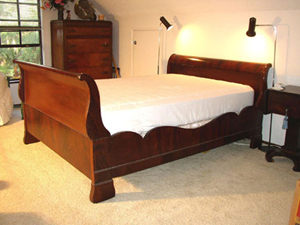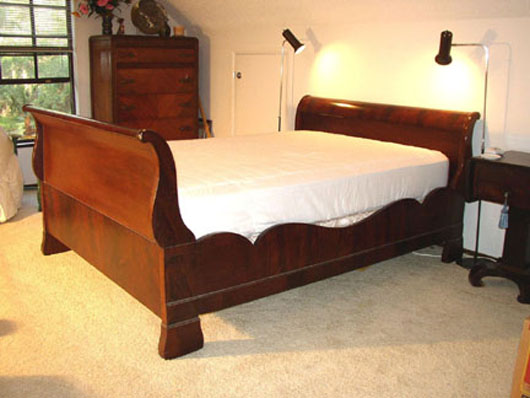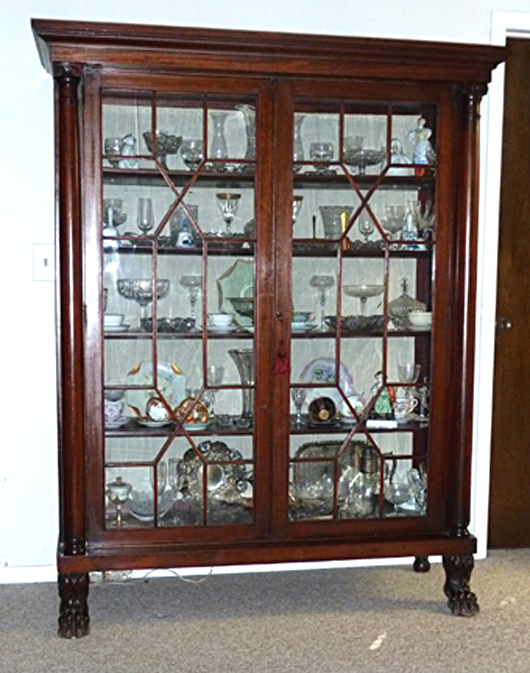
The only prior real purchase was at an auction Gail and I attended in the early 1980s. It was mostly an oak auction filled with Golden Oak chests and tables that dealers had acquired on the circuit in the Midwest during the summer. But this sale was in Florida in November and was attended largely by seasonal visitors from – of all places – the Midwest. They loved that Golden Oak stuff and bought carloads of it to take back home after Easter when they went north.
But we found a mahogany Empire sleigh bed, circa 1840, in good condition and promised ourselves we would not pay more than “X” dollars for it, a substantial sum at the time for us. We registered and got a bidder number. When the lot came to the block I eagerly entered my opening bid of $50. I apparently either misunderstood what the auctioneer said next or did not understand the process. He was asking for the next bid of $75 but I thought he said he had $75, so I upped my bid and won the lot against my own bid of $50 for $75. It was well worth the price and is still in use today. So far my outcomes at auctions had not been especially outstanding. Maybe I would have better luck next time.
About 25 years ago, early in our restoration business we redid a china cabinet for a customer, and when our efforts to get her to adopt us so we could inherit the cabinet turned to naught we began to look for one. We initially found several likely candidates, but the asking price was far out of our league. Over the years as I covered auctions for the trade press and wrote press releases for my auction clients we saw many similar cabinets, but they were not exactly what we wanted or the price was again out of our ballpark.
Once the auction business turned to the Internet, Gail entered our key words in an online service that notifies us of things coming to auction in the near future that match our key words. For several years she weeded out false starts, mislabeled items and wishful thinking until one day recently she yelled up the stairs “I found it!” And so she had. It was the cabinet of our dreams it appeared and it was being offered by an auctioneer in a distant state whose auctions I had covered in the past. I called him to ask him his presale estimate. With the “brown goods” market in the shape it’s in it was less than half what we were willing to spend so I registered as a phone bidder.
On auction day at the appointed time, a representative of the auction house called me at home and helped me through the bid procedure. All I had to do was to say “yes” as long as I could stand it. Turned out, as I learned after the sale, there was a dealer on the floor bidding for a customer who really wanted that cabinet. But apparently not as much as I did. I just kept saying “yes” until the dealer dropped out. I ended up paying slightly more than the presale high estimate but still comfortably within my price range even with the buyer’s premium and the shipping. Now I am eagerly awaiting the arrival of our “new” cabinet.
Although I did not actually attend the auction in person I could hear the auctioneer on the phone over the helpful assistant and I could follow the chant. It helped to have acquired a little vocabulary and knowledge about auctions since my early missteps and maybe some key words will help you at your next auction or perhaps even inspire you to attend one if you haven’t gone recently. Some but not all of these terms also apply to online auctions which are not conducted in real time.
First some presale terms of importance –
CONDITIONS OF SALE – This is the fine print seen in most auction ads and catalogs. It sets out the various house rules of the sale such as buyer’s premium, convenience fees, discounts, acceptable lines of credit, check acceptance policies, terms of delivery, etc. Be sure you are familiar with the conditions if you intend to bid.
RESERVE – This is the minimum price the owner/consignor of a piece of merchandise will accept at auction for the merchandise. This amount may or may not be disclosed before the sale; it usually is not. The owner is not legally obligated to accept any bid lower than the reserve but may do so at his/her discretion. Unless a sale is expressly advertised as an “Absolute Auction” or as “Without Reserve” it is normally understood that a sale has reserves on the items.
ABSOLUTE AUCTION – This is a sale at which there are no established reserves and every item offered for sale is sold to the highest bidder, no matter the price.
AS IS, WHERE IS – A term used by auction houses to expressly not guarantee that the item for sale is anything other that what you see in the place where you see it. It is a reinforcement of the “buyer beware” conditions that apply at all auctions and usually will appear in the CONDITIONS OF SALE notice.
ABSENTEE – This is a term that refers to someone who is not actually at the auction but who wishes to bid on an item. In this case they will have left a written bid expressing the highest price they will pay for an item. If the bidding does not reach or exceed their bid (called a “left bid”) they win the item for the next bid increment above the highest onsite bid that does not exceed their maximum price.
PHONE BID – In this case the bidder is participating in real time but is on the phone relaying his bid to an auction house representative.
During the sale –
LOT – This is what individual items for sale are called. A lot may also be a group of items to be sold together or offered for a “choice” bid.
BID INCREMENT – The informal amount by which successive bids increase during a sale. Higher priced items usually have higher bid increments. If the auctioneer is accepting bids increasing in $50 increments, say from $150 to $200, he may be unwilling to “split the bid” and accept a bid of $175. But then again he may. It’s up to the auctioneer.
JUMP BID – A tactic used to intimidate less committed buyers. A bidder may substantially increase the current bid over the bid increment to force out other bidders.
PASSED – What happens when an item does not reach its reserve price. It is “passed” or withdrawn from the sale.
BOUGHT IN – When it appears that an item will not reach a certain price, the “house” enters a bid so that it appears the item was sold but it actually was withdrawn at the auctioneer’s discretion to be offered for sale another time.
ONE MONEY – The price the auctioneer is seeking when a lot has multiple items – a pair of chairs for example for one price for the pair.
X TIMES THE MONEY – The opposite of “one money.” The bids are for one item only. If there are two items the final price is two times the bid, for three items, three times the bid, etc.
CHOICE BID – When there are multiple items in a lot, the auctioneer may ask for a choice bid meaning the winner gets his choice of any item in the lot for the winning bid. The auctioneer will then go the second highest bidder, the back up bid, and ask if he wants the any other item for the same money – if not the bidding starts over again for each item in the lot.
PHANTOM BID – Also known as a “chandelier” bid or an “off the wall” bid. This is a bid announced by the bid caller even though there is no bid of this amount. It is a device sometimes used by bid callers to keep the bid alive and moving upward.
FAIR WARNING – A phrase used by many auctioneers just before the hammer falls to indicate that he is about to accept the last bid and bidding on the item will cease. It serves notice that the sale is about to be over.
HAMMER PRICE – The winning bid.
After the sale you need to know –
BUYER’S PREMIUM – Known in the trade as “the juice,” it is the amount, expressed as a percentage of the winning bid, that is added to the final cost of the item. For example, with a buyer’s premium of 10 percent, an item that received a winning bid of $100 would cost the buyer $110 plus any applicable sales or use taxes.
CONVENIENCE FEE – This a charge imposed by some auction houses on sales which are paid for with a credit card as a way to recover the fees charged by the credit card companies. In some states this is against the merchant agreement so instead of charging a specific “convenience fee” the auction facility charges a higher buyer’s premium but discounts it for cash or check, leaving the credit card user still paying a higher fee.
Now all you have to do is pay the man and collect your merchandise.
Visit Fred’s website at www.furnituredetective.com. His book How To Be a Furniture Detective is available for $18.95 plus $3 shipping. Send check or money order to Fred Taylor, P.O. Box 215, Crystal River, FL 34423.
Fred and Gail Taylor’s DVD, Identification of Older & Antique Furniture ($17 + $3 shipping) and a bound compilation of the first 60 columns of Common Sense Antiques by Fred Taylor, ($25 + $3 shipping) are also available at the same address. For more information call 800-387-6377, fax 352-563-2916, or e-mail info@furnituredetective.com. All items are also available directly from the website.
ADDITIONAL IMAGES OF NOTE



